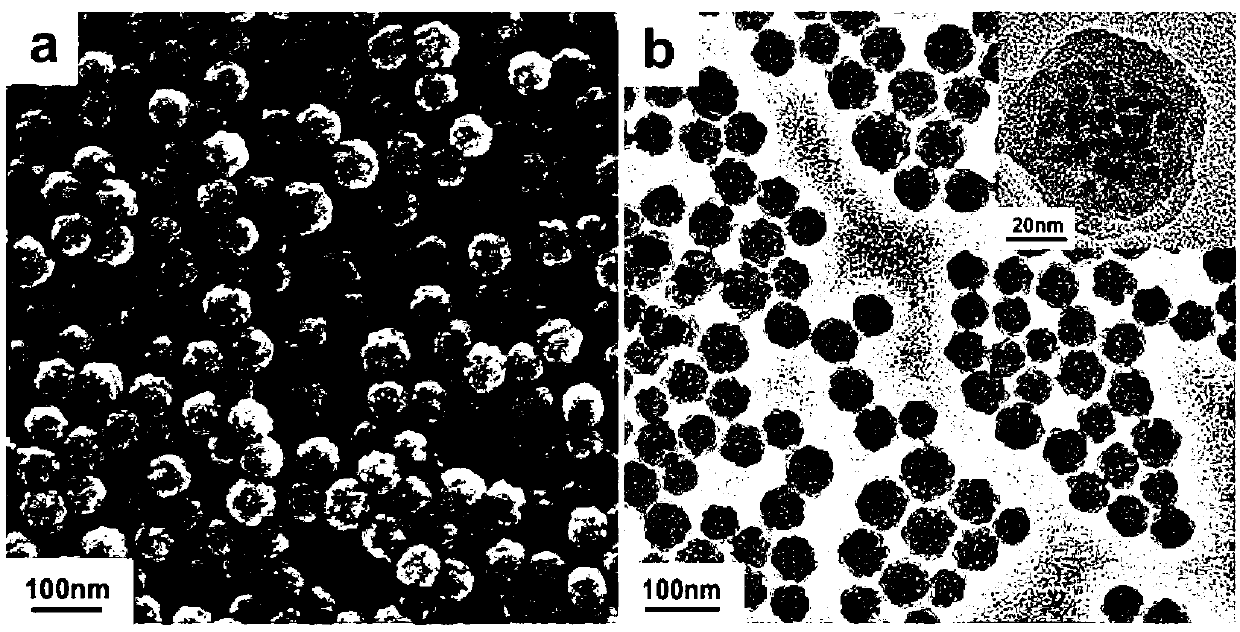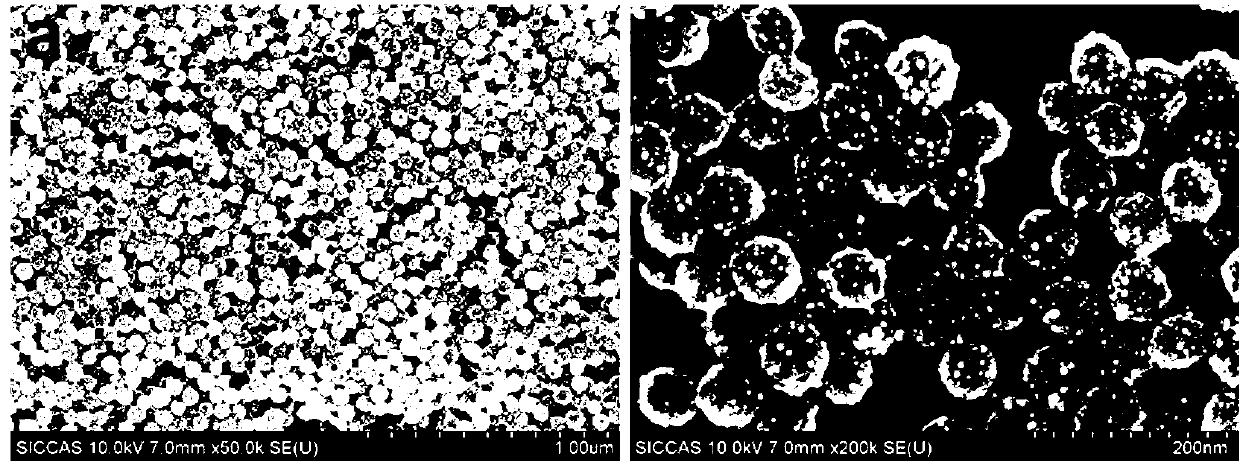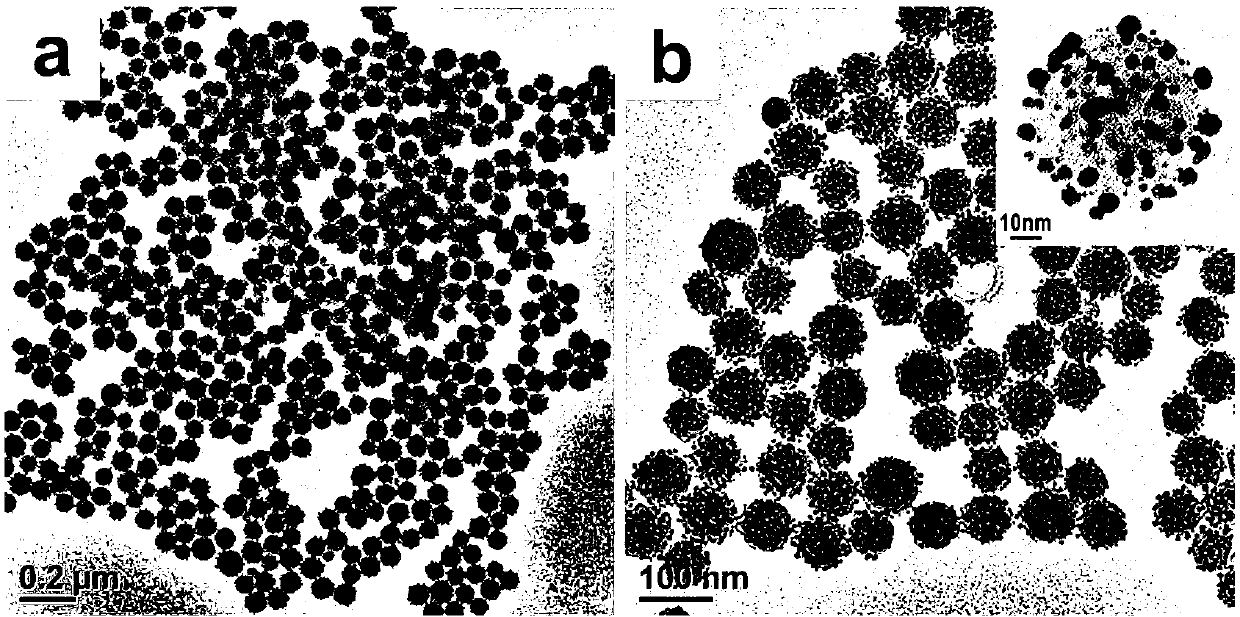Multifunctional composite nanoparticle and preparation method and application thereof
A nano-composite, gold nano-particle technology, applied in the coating and other directions, can solve the problems of unstable composite particle structure/performance, complex preparation process, etc., and achieve the effects of enhanced magnetic resonance imaging effect, good repeatability, and novel preparation method.
- Summary
- Abstract
- Description
- Claims
- Application Information
AI Technical Summary
Problems solved by technology
Method used
Image
Examples
Embodiment 1
[0035] At room temperature, the magnetic Fe3O4 particles (Fe 3 o 4 ) with amphiphilic block copolymer polystyrene-b-polyacrylic acid (PS 88 -b-PAA 8.7 ) and tetrahydrofuran (THF) according to the molar ratio for Fe 3 o 4 :PS 88 -b-PAA 8.7 :THF=42:1:1.2×10 5 The ratio of (ie 10mg Fe 3 o 4 , 10mg PS-b-PAA and 10ml THF) were evenly mixed, then 40ml ultrapure water was added to the solution, stirring was continued for 30min and then dialyzed in deionized water for 24h. Ammonia (NH3 .H 2 O) with mercaptopropyltrimethoxysilane (MPTMS) in molar ratio as NH 3 .H 2 O:MPTMS=8.69:1 (ie 1g ammonia water and 150mgMPTMS) was added to the above dialyzed solution, and the stirring was continued for 24 hours to obtain a thiol-functionalized shell-crosslinked magnetic core with a particle size of about 60nm.
[0036] In 15ml of the colloidal solution obtained above, the molar ratio was 1.66×10 5 : 1.5: 1 Add 120ml ultrapure water, 4ml 0.01M gold chloride (HAuCl 4 ) with 6ml of 0.0...
Embodiment 2
[0038] The mercapto-functionalized shell-crosslinked magnetic composite particles prepared in the above examples, and the composite nanocomposite particles of ferroferric oxide and gold nanoparticles were respectively characterized by transmission and scanning electron microscopy, and their respective morphological characteristics and structures are as follows: Figure 2-4 shown. As can be seen from the figure, the diameter of the magnetic inner core formed by the magnetic ferroferric oxide particles is about 50-70nm, and the diameter of the composite particles is about 60-80nm.
[0039] Finally, the obtained multifunctional nanocomposite particles with core-shell structure were tested in a medical magnetic resonance imager (1.5T) for imaging capability. The results show that the retardation rate r of the composite particles in the in vitro environment 2 The value reached 241mM -1 S -1 ( Figure 5 ), and as the iron content in the solution increases, the T of the reagent ...
Embodiment 3
[0041] The basic formula remains unchanged, and only the pH value of the solution before adding sodium borohydride is changed to obtain the following several embodiments, and the resulting TEM photos are as follows: Figure 8-9 Shown:
[0042] (a) The pH of the solution was adjusted to 8.0 before adding sodium borohydride ( Figure 8 )
[0043] (b) The pH of the solution was adjusted to 9.5 before adding sodium borohydride ( Figure 9 )
[0044] From the analysis results of transmission electron microscopy, the following conclusions can be drawn. As the pH value of the solution before adding sodium borohydride increases, the gold nanoparticles grafted onto the magnetic microspheres become smaller, indicating that adjusting the pH value of the solution can effectively control the reduced gold nanoparticles. The size also confirms that this method has good adjustability.
PUM
| Property | Measurement | Unit |
|---|---|---|
| diameter | aaaaa | aaaaa |
| diameter | aaaaa | aaaaa |
| diameter | aaaaa | aaaaa |
Abstract
Description
Claims
Application Information
 Login to View More
Login to View More - R&D
- Intellectual Property
- Life Sciences
- Materials
- Tech Scout
- Unparalleled Data Quality
- Higher Quality Content
- 60% Fewer Hallucinations
Browse by: Latest US Patents, China's latest patents, Technical Efficacy Thesaurus, Application Domain, Technology Topic, Popular Technical Reports.
© 2025 PatSnap. All rights reserved.Legal|Privacy policy|Modern Slavery Act Transparency Statement|Sitemap|About US| Contact US: help@patsnap.com



